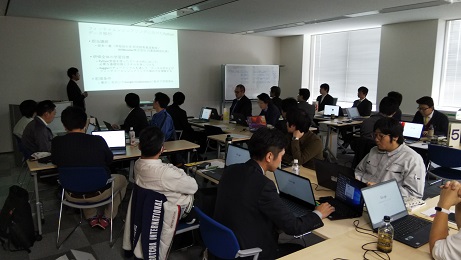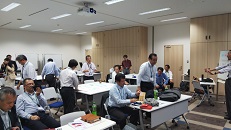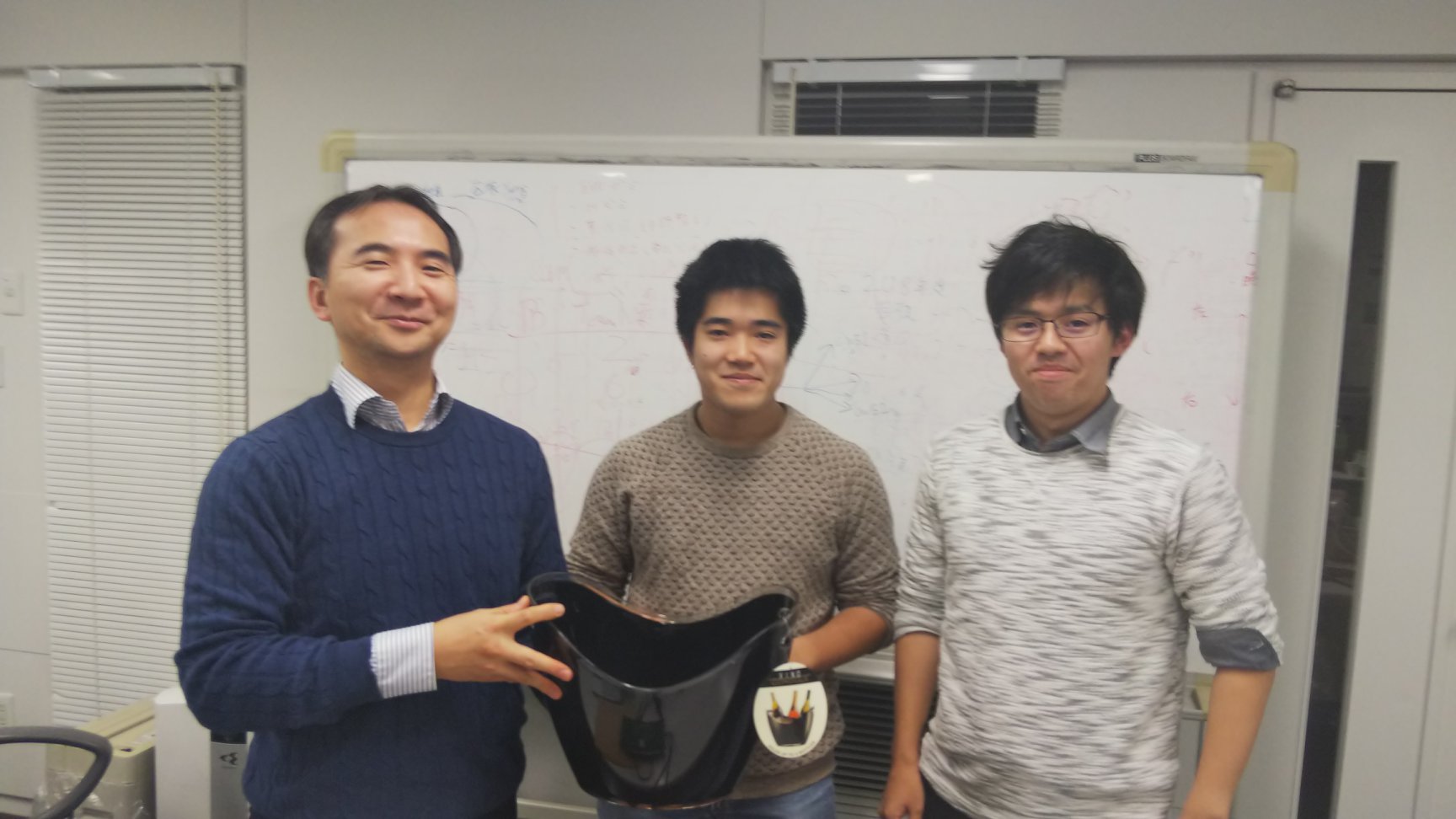女子学生を対象にGoogle JapanとWomen in Tech Waseda開催(情報理工・情報通信専攻、博士キャリアセンター、グローバル科学知融合研究所、グローバルソフトウェアエンジニアリング研究所共催、ダイバーシティ推進室 協力)講演やワークショップを通じ多様性やキャリアを考える貴重な機会となりました。
カテゴリー別アーカイブ: 未分類
IEEE CS Japan Young Author Award講演・スマートエスイー説明交流フォーラム 12/23
IEEE CS Japan Young Author Award講演・スマートエスイー説明交流フォーラム 12/23 早大: クラウドにおけるライブマイグレーション・差分プライバシーの受賞講演。スマートエスイー受講者募集説明会・成果紹介。産学連携の技術研究交流フォーラム開催。ぜひご参加ください。
============================================
Young Author Award 受賞記念講演会・スマートエスイー 受講者募集説明会
スマートエスイーコンソーシアム 2019年度 技術研究交流フォーラム
https://smartse.jp/information/2019/1125121343/
https://www.ieee-jp.org/section/tokyo/chapter/C-16/
2019年12月23日に早稲田大学にて、IEEE Computer Society Japan
Chapter Young Author Award (YAA) 受賞記念講演会を行います。
超スマート社会の基盤技術に関しトップジャーナルやカンファレンスで認め
られた世界最先端の話題として、クラウドにおけるライブマイグレーション
および差分プライバシーのリスク定量化の講演を受賞者からいただきます。
加えて同会場にて、超スマート社会実現に欠かせない人材育成と産学連携
に向けた技術研究交流フォーラムを、社会人教育プログラム enPiT-Pro
スマートエスイーの2020年度受講者募集説明会・成果紹介を中心に実施
します。ぜひ参加申し込みフォームより参加登録ください。技術研究交流
フォーラム(懇親会)では、情報系技術のポスター展示を大学や企業から
広く募集します。ご希望の方は合わせて問い合わせ先にご連絡ください。
日時: 2019年12月23日(月) 16:00-20:10
場所: 早稲田大学グリーンコンピューティングシステム研究開発センター
https://www.waseda.jp/inst/gcs/access/
参加費: 講演会・説明会 無料、研究交流フォーラムは3000円程度
主催: IEEE Computer Society Tokyo/Japan Joint Chapter
enPiT-Pro スマートエスイー、スマートエスイーコンソーシアム
共催: 早稲田大学理工学術院総合研究所最先端ICT基盤研究所
早稲田大学グローバルソフトウェアエンジニアリング研究所
協賛: IEEE Computer Society Kansai Chapter
IEEE Computer Society Fukuoka Chapter
早稲田大学オープンイノベーション戦略研究機構(予定)
参加申込み: https://smartse.jp/information/2019/1125121343/
16:00-17:30 IEEE CS Japan Chapter Young Author Award 受賞記念講演会
“Live Migration in Bare-metal Clouds”
(IEEE Transactions on Cloud Computing)
深井 貴明 (東京大学)
“Quantifying Differential Privacy under Temporal Correlations”
(2017 IEEE 33rd International Conference on Data Engineering (ICDE))
曹 洋 (京都大学大学院)
17:40-18:50 スマートエスイー 説明・成果紹介
“Society 5.0に向けたIoT・AI デジタル人材育成:スマートエスイーの成果
と展望 – 2019年度までの成果報告および2020年度カリキュラム紹介ほか”
鷲崎 弘宜 (早稲田大学、スマートエスイー事業責任者)
“増え続けるAI案件を効率的に取り組むためのデータ活用ゴールモデリング”(予定)
奥谷 大介(2019年度修了者)
“深層学習を利用した異常品検出支援システム”(予定)
大甲 隼土(2019年度修了者)
“IoTプラットフォームビジネス・エコシステム構築手法の提案”(予定)
八十岡 恒人、矢頭 岳人(2018年度修了者)
19:00-20:10 技術研究交流フォーラム(ポスター展示・懇親会)
大学・企業、コンソーシアム会員、スマートエスイー修了者、希望者
からのポスター展示ならびに交流懇親会
ポスター展示ご希望の方は smartse-consortium [at] list.waseda.jp
にご連絡ください。
============================================
Machine Learning Architecture and Design Patterns
Last update: December 18th, 2021
Practitioners and researchers study best practices to design machine learning (ML) application
systems and software to address quality and constraint problems. Such practices are often
formalized as design patterns. In this study, a multi-vocal literature review identified 15 software engineering design patterns for ML applications. A questionnaire survey inquired about ML developers’ use of the ML design patterns to validate them in practice. 118 ML developers responded to our survey. Results show that developers were unfamiliar with most of the patterns, although there are several major patterns already used by 20+% of the respondents. For all patterns, most of the respondents would consider using them in future designs. As the respondents became more consistent in their approach to design problems by reuse, the pattern usage ratio increased. These findings suggest that there are opportunities to increase the patterns’ adoption in practice by raising awareness of such patterns within the community.
Project members
- Hironori Washizaki, Dept. of Computer Science and Engineering, Waseda University, Tokyo, Japan, National Institute of Informatics, Tokyo, Japan
- Yann-Gael Gueheneuc, Ptidej Team, DGIGL, Ecole Polytechnique de Montreal, Quebec, Canada
- Foutse Khomh, Ptidej Team, DGIGL, Ecole Polytechnique de Montreal, Quebec, Canada
- Hironori Takeuchi
- Naotake Natori
- Takuo Doi
- Satoshi Okuda
- Nobukazu Yoshioka
Funds and Grants
This work was supported by JST-Mirai JPMJMI20B8 Engineerable AI Project, JSPS JPJSBP 120209936, and KAKENHI 21KK0179.
Publications
- Hironori Washizaki, Foutse Khomh, Yann-Gael Gueheneuc, Hironori Takeuchi, Naotake Natori, Takuo Doi, Satoshi Okuda, “Software Engineering Design Patterns for Machine Learning Applications,” IEEE Computer, Vol. 55, No. 3, pp. 1-9, 2022. (preliminary preprint)
- Nobukazu Yoshioka, Hironori Washizaki, Eduardo B. Fernandez, Tomoko Kaneko, Shuichiro Yamamoto, Fuyuki Ishikawa, Foutse Khomh, Giuliano Antoniol, Proceedings of the International Workshop on Evidence-based Security and Privacy in the Wild and the 1st International Workshop on Machine Learning Systems Engineering, CEUR Workshop Proceedings, Vol-2809, 2021.
- Hnin Thandar Tun, Jati H. Husen, Nobukazu Yoshioka Yoshioka, Hironori Washizaki and Yoshiaki Fukazawa, “Goal-Centralized Metamodel Based Requirements Integration for Machine Learning Systems,” 3rd International Workshop on Machine Learning Systems Engineering (iMLSE 2021), December 6, 2021, Virtual – in Conjunction with APSEC 2021
- Nobukazu Yoshioka, Jati H. Husen, Hnin Thandar Tun, Zhenxiang Chen, Hironori Washizaki and Yoshiaki Fukazawa, “Landscape of Requirements Engineering for Machine Learning-based AI Systems,” 3rd International Workshop on Machine Learning Systems Engineering (iMLSE 2021), December 6, 2021, Virtual – in Conjunction with APSEC 2021
- Jomphon Runpakprakun, Sien Reeve Ordonez Peralta, Hironori Washizaki, Foutse Khomh, Yann-Gael Gueheneuc, Nobukazu Yoshioka, Yoshiaki Fukazawa, “Software Engineering Patterns for Machine Learning Applications (SEP4MLA) – Part 3 – Data Processing Architectures,” 28th Conference on Pattern Languages of Programs (PLoP 2021), pp. 1-11, 2021.
- Jati H. Husen, Hnin Thandar Tun, Nobukazu Yoshioka, Hironori Washizaki and Yoshiaki Fukazawa, “Goal-Oriented Machine Learning-Based Component Development Process,” ACM/IEEE 24th International Conference on Model Driven Engineering Languages and Systems (MODELS), Poster Track, pp. 1-2, online, Sun 10 – Fri 15 October 2021.
- Yasuhiro Watanabe, Hironori Washizaki, Kazunori Sakamoto, Daisuke Saito, Kiyoshi Honda, Naohiko Tsuda, Yoshiaki Fukazawa, Nobukazu Yoshioka, “Preliminary Literature Review of Machine Learning System Development Practices,” 45th IEEE Computer Society Signature Conference on Computers, Software and Applications (COMPSAC 2021), Fast Abstract, pp. 1-2, 2021.
- Hironori Washizaki, Hironori Takeuchi, Foutse Khomh, Naotake Natori, Takuo Doi, Satoshi Okuda, “Practitioners’ insights on machine-learning software engineering design patterns: a preliminary study,” 36th IEEE International Conference on Software Maintenance and Evolution (ICSME 2020), Late Breaking Ideas track, Sep 26 – Oct 3, 2020.
- Hironori Washizaki, Hironori Takeuchi, Yann-Gaël Guéhéneuc, Foutse Khomh, Naotake Natori, Naohisa Shioura and Takuo Doi, “Machine-Learning Software-Engineering Design Patterns: Literature Review and Practitioners’ Insights,” Poster, 2nd International Workshop on Machine Learning Systems Engineering (iMLSE 2020), December 1, 2020, Virtual – in Conjunction with APSEC 2020
- Hironori Washizaki, Foutse Khomh, Yann-Gaël Guéhéneuc, Hironori Takeuchi, Satoshi Okuda, Naotake Natori, Naohisa Shioura, “Software Engineering Patterns for Machine Learning Applications (SEP4MLA) – Part 2”, the 27th Conference on Pattern Languages of Programs in 2020 (PLoP’20), October 12-16, 2020
- Hironori Washizaki, Foutse Khomh, Yann-Gael Gueheneuc, “Software Engineering Patterns for Machine Learning Applications (SEP4MLA),” 9th Asian Conference on Pattern Languages of Programs (AsianPLoP 2020), March 4-6, 2020, Taipei, Taiwan
- Hironori Washizaki, Hiromu Uchida, Foutse Khomh and Yann-Gaël Guéhéneuc, “Studying Software Engineering Patterns for Designing Machine Learning Systems,” The 10th International Workshop on Empirical Software Engineering in Practice (IWESEP 2019), Tokyo, Japan, on December 13-14, 2019.
Others and Data
- Valliappa Lakshmanan, Sara Robinson, Michael Munn著, 鷲崎弘宜, 竹内広宜, 名取直毅, 吉岡信和 訳, “機械学習デザインパターン – データ準備、モデル構築、MLOpsの実践上の問題と解決”(原著 “Machine Learning Design Patterns”), オライリージャパン, 2021.
- Hironori Washizaki, List of documents and patterns identified by multivocal literature review of software engineering patterns for machine learning applications, zenodo, 2021
- List of patterns 機械学習応用システムのアーキテクチャ・デザイパターン (under construction)
Contact
Project leader: Hironori Washizaki, washizaki [at] waseda.jp
JAIST金沢駅前オフィスにてスマートエスイーコンソーシアム 機械学習・深層学習 研修(基礎編)実施 2019年11月20-21日
鷲崎教授がJASPICアジャイル分科会にてアジャイル品質パターンについて講演・QA2AQパターンカードを用いたワークショップを実施
Lab students celebrated birthday of Prof. Washizaki. Thank you! 学生がサプライズで鷲崎教授の誕生日をお祝いしてくれました。
AI・IoT×ビジネスの社会人教育enPiT-Proスマートエスイー(代表: 鷲崎)は IMS Japan賞 特別賞を受賞
AI・IoT×ビジネスの社会人教育enPiT-Proスマートエスイー(代表: 鷲崎)は IMS Japan賞 特別賞を受賞しました。e-Learning大賞に続いての受賞。講師や連携機関ほか関係各位、熱心な受講生の皆様に御礼申し上げますとともにますます丁寧に、より内容を高めつつ広げてまいります。
The team PICOPICOPON incl. M0 Ryoya Yoshimura (as contestant) and M2 Remin Kasahara (as coach) won the 11th place among 65 teams at ACM-ICPC 2019 Yokohama Regional. The team CoprimE incl. Ryo Ishizuka (as coach) won 52nd place.
The team PICOPICOPON incl. M0 Ryoya Yoshimura (as contestant) and M2 Remin Kasahara (as coach) won the 11th place among 65 teams at ACM-ICPC 2019 Yokohama Regional. The team CoprimE incl. Ryo Ishizuka (as coach) won the 52nd place. Congratulations!
研究室 M0 吉村君(選手)、M2 笠原君(コーチ)が参画するチーム PICOPICOPON が ACM-ICPC 2019 Yokohama Regional にて65チーム中11位の成績を収めました。また、M2 石塚君(コーチ)が参画するチーム CoprimE が52位の成績を収めました。おめでとう!
スマートエスイーセミナーにて機械学習システムの33のアーキテクチャパターンおよびデザインパターンを紹介
スマートエスイーセミナーにて機械学習システムの33のアーキテクチャパターンおよびデザインパターンを紹介させていただきました。多くのご参加ならびにワークショップ参画、有難うございました。講演資料を掲載いたします。IWESEP2019 にもぜひご参加ください。
- 鷲崎弘宜, 機械学習システムの33のアーキテクチャパターンおよびデザインパターン, スマートエスイーセミナー: 機械学習デザインパターンとアジャイル品質パターン, 2019年11月8日(金), 早稲田大学 西早稲田キャンパス
Agile Tour Osakaにてアジャイル品質パターンのワークショップを実施
Agile Tour Osakaにてアジャイル品質パターンのワークショップを実施。多くのご参加、有難うございました!ご要望がありましたので、アジャイル品質パターンカードを掲載しました。ぜひご利用ください。パターン記述の和訳は今月中を目途に公開を予定しています。
- 鷲崎弘宜, アジャイル品質パターンの紹介とワークショップ, Agile Tour Osaka, 2019年11月9日






